Published online by Cambridge University Press: 05 October 2022

1. Snitzki and Stone, 819 W. Roseburg Ave., Suite 240, Modesto, Calif. 95350. Telephone (209) 571–0646.
2. Bonnie Burt Productions, 2600 Tenth Street, Suite 205, Berkeley, Calif. 94710. Telephone (510) 548–1745.
3. Tony Masland, “Learning to Keep the Faith,” Newsweek, 13 Mar. 1995, p. 30.
4. Enrique López Oliva, “Religious Reawakening: Stirrings in Cuba,” The Christian Century, 19 Oct. 1994, p. 940.
5. The phrase is taken from Judith Laikin Elkin, “Exploring the Jewish Archipelago in Latin America,” LARR 30, no. 3 (1995):225.
6. Julianne Burton, “Toward a History of Social Documentary in Latin America,” in The Social Documentary in Latin America, edited by Julianne Burton (Pittsburgh, Pa.: University of Pittsburgh Press, 1990); and Bill Nichols, Representing Reality (Bloomington: Indiana University Press, 1991).
7. A minyan traditionally consists or ten adult men. Fulfilling a minyan was so difficult in the 1980s that the community frequently asked foreign visitors to join them. Chuck Kleinhans, associate professor in the Department of Radio/Television/Film at Northwestern University and co-editor of JumpCut, recalls that on a trip to the Havana film festival in 1985, he was approached in his hotel and asked to join a minyan so that the community could hold services.
8. The term conversos refers to Jews who, under pressure from the Spanish Inquisition, converted to Catholicism. Conversos and their descendants, also called New Christians, were frequently subject to the scrutiny of Inquisitors and zealots who ardently sought out “Judaizers,” meaning those accused of practicing Christianity in public and perpetuating their Jewish beliefs and traditions in secret.
9. Robert M. Levine, Tropical Diaspora: The Jewish Experience in Cuba (Gainesville: University Press of Florida, 1993), 251.
10. Ibid., 276.
11. “The Story of David Said Levy, the Rabbinical Student, Is Told in ‘Latkes, bueno!,‘” New Yorker, 10 Dec. 1993, pp. 57–59.
12. Burton, Social Documentary in Latin America, 5.
13. Bar mitzvah translates literally as “son of the Torah.” It is the religious ritual by which a thirteen-year-old boy achieves adult standing within the Jewish community (a girl performs a “bat mitzvah” as a “daughter of the Torah”). As part of this rite of passage, the child must read in Hebrew publicly and comment on a portion of the Torah.
14. Yelin's father Saúl Yelin was a secular Jew and one of the founders of ICAIC.
15. Non-diegetic refers to the fact that the music lacks a visible source and is therefore assumed to originate from outside the film's story.
16. Both videos end with an address to which the viewer can write for further information about contributing to the cause of the Cuban Jewish community.